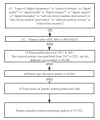Evolution of Digital Health and Exploration of Patented Technologies (2017-2021): Bibliometric Analysis
- PMID: 38991212
- PMCID: PMC11273069
- DOI: 10.2196/48259
Evolution of Digital Health and Exploration of Patented Technologies (2017-2021): Bibliometric Analysis
Abstract
Background: The significant impact of digital health emerged prominently during the COVID-19 pandemic. Despite this, there is a paucity of bibliometric analyses focusing on technologies within the field of digital health patents. Patents offer a wealth of insights into technologies, commercial prospects, and competitive landscapes, often undisclosed in other publications. Given the rapid evolution of the digital health industry, safeguarding algorithms, software, and advanced surgical devices through patent systems is imperative. The patent system simultaneously acts as a valuable repository of technological knowledge, accessible to researchers. This accessibility facilitates the enhancement of existing technologies and the advancement of medical equipment, ultimately contributing to public health improvement and meeting public demands.
Objective: The primary objective of this study is to gain a more profound understanding of technology hotspots and development trends within the field of digital health.
Methods: Using a bibliometric analysis methodology, we assessed the global technological output reflected in patents on digital health published between 2017 and 2021. Using Citespace5.1R8 and Excel 2016, we conducted bibliometric visualization and comparative analyses of key metrics, including national contributions, institutional affiliations, inventor profiles, and technology topics.
Results: A total of 15,763 digital health patents were identified as published between 2017 and 2021. The China National Intellectual Property Administration secured the top position with 7253 published patents, whereas Koninklijke Philips emerged as the leading institution with 329 patents. Notably, Assaf Govari emerged as the most prolific inventor. Technology hot spots encompassed categories such as "Medical Equipment and Information Systems," "Image Analysis," and "Electrical Diagnosis," classified by Derwent Manual Code. A patent related to the technique of receiving and transmitting data through microchips garnered the highest citation, attributed to the patentee Covidien LP.
Conclusions: The trajectory of digital health patents has been growing since 2017, primarily propelled by China, the United States, and Japan. Applications in health interventions and enhancements in surgical devices represent the predominant scenarios for digital health technology. Algorithms emerged as the pivotal technologies protected by patents, whereas techniques related to data transfer, storage, and exchange in the digital health domain are anticipated to be focal points in forthcoming basic research.
Keywords: CiteSpace5.1R8; bibliometric analysis; digital health; patent; technology trends.
©Wenjun Gu, Jinhua Wang, Yunqi Zhang, Shaolin Liang, Zisheng Ai, Jiyu Li. Originally published in the Interactive Journal of Medical Research (https://www.i-jmr.org/), 11.07.2024.
Conflict of interest statement
Conflicts of Interest: None declared.
Figures







Similar articles
-
Nanotechnology and Protection of Intellectual Property: Emerging Trends.Recent Pat Nanotechnol. 2020;14(4):307-327. doi: 10.2174/1872210514666200612174317. Recent Pat Nanotechnol. 2020. PMID: 32532198
-
A Case Study: Analysis of Patents on Coronaviruses and Covid-19 for Technological Assessment and Future Research.Curr Pharm Des. 2021;27(3):423-439. doi: 10.2174/1381612826666200720233947. Curr Pharm Des. 2021. PMID: 32693757
-
Research Trends in the Application of Artificial Intelligence in Oncology: A Bibliometric and Network Visualization Study.Front Biosci (Landmark Ed). 2022 Aug 31;27(9):254. doi: 10.31083/j.fbl2709254. Front Biosci (Landmark Ed). 2022. PMID: 36224012
-
Identification of technology frontiers of artificial intelligence-assisted pathology based on patent citation network.PLoS One. 2022 Aug 22;17(8):e0273355. doi: 10.1371/journal.pone.0273355. eCollection 2022. PLoS One. 2022. PMID: 35994484 Free PMC article. Review.
-
Hotspots and trends of biological water treatment based on bibliometric review and patents analysis.J Environ Sci (China). 2023 Mar;125:774-785. doi: 10.1016/j.jes.2022.03.037. Epub 2022 Apr 4. J Environ Sci (China). 2023. PMID: 36375959 Review.
Cited by
-
Evaluating the evidence: a systematic review of reviews of the effectiveness and safety of digital interventions for ADHD.BMC Psychiatry. 2025 Apr 22;25(1):414. doi: 10.1186/s12888-025-06825-0. BMC Psychiatry. 2025. PMID: 40264083 Free PMC article.
References
-
- Digital therapeutics alliance homepage. Digital Therapeutics Alliance. [2021-08-09]. https://dtxalliance.org/
-
- Digital therapeutics definition and core principles. Digital Therapeutics Alliance. [2021-09-10]. https://dtxalliance.org/wp-content/uploads/2021/01/DTA_DTx-Definition-an... .
-
- Canonico ME, Hsia J, Guthrie NL, Simmons M, Mehta P, Lupinacci P, Edwards K, Mosesso K, Gearhart M, Skuban A, Bonaca MP, Berman MA. Cognitive behavioral therapy delivered via digital mobile application for the treatment of type 2 diabetes: rationale, design, and baseline characteristics of a randomized, controlled trial. Clin Cardiol. 2022 Aug;45(8):850–6. doi: 10.1002/clc.23853. https://europepmc.org/abstract/MED/35778834 - DOI - PMC - PubMed
LinkOut - more resources
Full Text Sources

